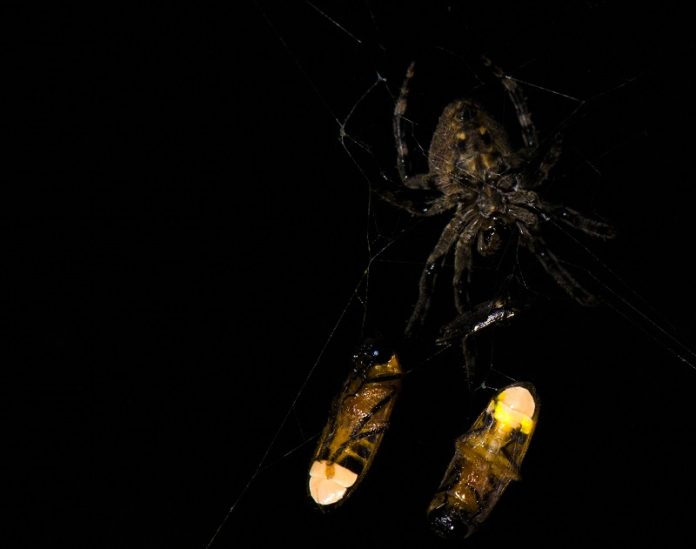
Fireflies are well-known for their glowing flashes, which they use to communicate and attract mates.
Male fireflies of the species Abscondita terminalis create multi-pulse flashes with two light-emitting lanterns on their abdomens to attract females.
In contrast, female fireflies make single-pulse flashes with their one lantern to signal to males.
However, a recent study published in the journal Current Biology has uncovered a clever and sneaky strategy used by an orb-weaving spider (Araneus ventricosus) to catch more prey.
The spider manipulates the flashing signals of male fireflies trapped in its web, making them mimic the flashes of female fireflies.
This deceptive tactic lures other male fireflies to the web, where they too become the spider’s next meal.
The study was led by Xinhua Fu from Huazhong Agricultural University in China, who first noticed an unusual pattern in the field.
He observed that many male fireflies were caught in the webs of orb-weaving spiders, but hardly any females were present.
This strange pattern led Fu to suspect that the spiders might be somehow influencing the behavior of the trapped male fireflies to attract more males.
To test this theory, Fu teamed up with behavioral ecologists Daiqin Li and Shichang Zhang from Hubei University.
Together, they conducted field experiments to closely observe the spider’s behavior and the flashing signals of the fireflies.
Their experiments showed that male fireflies were more likely to be caught in the web when the spider was present compared to when the web was empty.
A closer analysis revealed that the trapped male fireflies were changing their signals in a way that made them look more like female fireflies.
Instead of using both lanterns to create multi-pulse flashes, the ensnared males started using single-pulse flashes with just one lantern—exactly like a female firefly.
Interestingly, the researchers found that the trapped males didn’t make these changes as a distress signal. Instead, they believe that the spider somehow influences the firefly’s flashing pattern.
When the spider detects the firefly’s bioluminescent signals, it uses a special technique involving repeated wrap-bite attacks to manipulate the trapped insect.
The findings from this study show how animals can use indirect and clever signals to target specific prey in nature. The researchers suggest that there could be many more undiscovered examples of predators using mimicry to manipulate their prey’s behavior, whether through visual signals, sounds, pheromones, or other methods.
The study also raises questions about whether the spider’s venom or bite directly causes the changes in the firefly’s flashing pattern.
More research is needed to fully understand this fascinating interaction between the spider and its prey.



